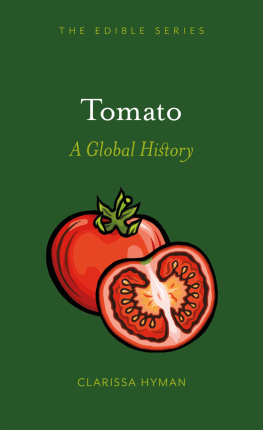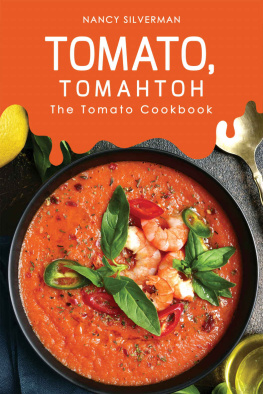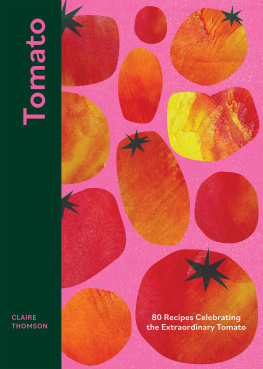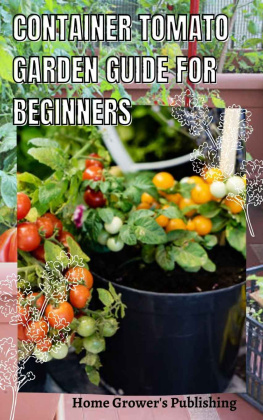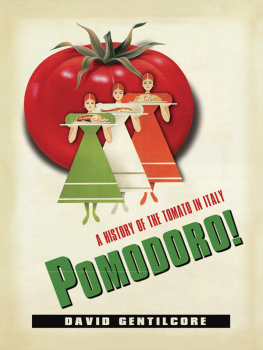TOMATO

Edible
Series Editor: Andrew F. Smith
EDIBLE is a revolutionary series of books dedicated to food and drink that explores the rich history of cuisine. Each book reveals the global history and culture of one type of food or beverage.
Already published
Apple Erika Janik Banana Lorna Piatti-Farnell
Barbecue Jonathan Deutsch and Megan J. Elias Beef Lorna Piatti-Farnell
Beer Gavin D. Smith Berries Heather Arndt Anderson
Biscuits and Cookies Anastasia Edwards Brandy Becky Sue Epstein
Bread William Rubel Cabbage Meg Muckenhoupt Cake Nicola Humble
Caviar Nichola Fletcher Champagne Becky Sue Epstein
Cheese Andrew Dalby Chillies Heather Arndt Anderson
Chocolate Sarah Moss and Alexander Badenoch
Cocktails Joseph M. Carlin Coffee Jonathan Morris
Corn Michael Owen Jones Curry Colleen Taylor Sen
Dates Nawal Nasrallah Doughnut Heather Delancey Hunwick
Dumplings Barbara Gallani Edible Flowers Constance L. Kirker
and Mary Newman Eggs Diane Toops Fats Michelle Phillipov
Figs David C. Sutton Game Paula Young Lee
Gin Lesley Jacobs Solmonson Hamburger Andrew F. Smith
Herbs Gary Allen Herring Kathy Hunt Honey Lucy M. Long
Hot Dog Bruce Kraig Ice Cream Laura B. Weiss Lamb Brian Yarvin
Lemon Toby Sonneman Lobster Elisabeth Townsend
Melon Sylvia Lovegren Milk Hannah Velten Moonshine Kevin R. Kosar
Mushroom Cynthia D. Bertelsen Nuts Ken Albala Offal Nina Edwards
Olive Fabrizia Lanza Onions and Garlic Martha Jay
Oranges Clarissa Hyman Oyster Carolyn Tillie Pancake Ken Albala
Pasta and Noodles Kantha Shelke Pickles Jan Davison Pie Janet Clarkson
Pineapple Kaori OConnor Pizza Carol Helstosky
Pomegranate Damien Stone Pork Katharine M. Rogers
Potato Andrew F. Smith Pudding Jeri Quinzio Rice Renee Marton
Rum Richard Foss Salad Judith Weinraub Salmon Nicolaas Mink
Sandwich Bee Wilson Sauces Maryann Tebben Sausage Gary Allen
Seaweed Kaori OConnor Shrimp Yvette Florio Lane
Soup Janet Clarkson Spices Fred Czarra Sugar Andrew F. Smith
Sweets and Candy Laura Mason Tea Helen Saberi Tequila Ian Williams
Tomato Clarissa Hyman Truffle Zachary Nowak Vodka Patricia Herlihy
Water Ian MilleR Whiskey Kevin R. Kosar Wine Marc Millon
Tomato
A Global History
Clarissa Hyman
REAKTION BOOKS
Published by Reaktion Books Ltd
Unit 32, Waterside
4448 Wharf Road
London N1 7UX, UK
www.reaktionbooks.co.uk
First published 2019
Copyright Clarissa Hyman 2019
All rights reserved
No part of this publication may be reproduced, stored in a retrieval system, or transmitted, in any form or by any means, electronic, mechanical, photocopying, recording or otherwise, without the prior permission of the publishers
Page references in the Photo Acknowledgements and
Index match the printed edition of this book.
Printed and bound in China by 1010 Printing International Ltd
A catalogue record for this book is available from the British Library
eISBN 9781789141160
Recipe for Tomates la Lucie () from Joseph Delteil, La Cuisine palolithique (ditions de Paris: Paris, 2017) reproduced by kind permission of Les ditions de Paris.
Contents

Introduction

At first sight there may seem little to connect the Chilean poet Pablo Neruda and the American country singer-songwriter John Denver, but they both have devoted verses to the tomato. In Ode to Tomatoes, the former takes pleasure in the quotidian and describes how the union of the tomato with onion, oil, pepper and salt offers a gift/ of fiery colour/ and cool completeness, while Denver sagely sings about two things whose value is beyond measure, love and home-grown tomatoes.
Yet, the tomato is anything but commonplace. The tomato world is a rainbow nation of shapes, colours, textures and sizes, from luscious, curvaceous and ribbed forms to clusters of tight little cherries, tart and cheery green toms and elongated plums. They range from the perfectly round (globe) to the highly flattened (oblate); they can be oval or egg-shaped, long and slender, segmented, heart or pear-shaped. They can be as small as a pea or as large as a grapefruit: imagine, if you will, a mouse next to an elephant.
There is a tomato for every time, place or use. Cherry, grape and cocktail tomatoes have conquered the snacking world; the large beefsteak has nothing to do with flavour and everything to do with texture and density. Tomatoes can be juicy or dry, soft or succulent, and the balance between acid and sweet, fullness and blandness, complexity and simplicity is the benchmark of a good tomato, as is the dominance of juice over water. Today there is a multitude of choice also in terms of colour and markings: pale orange, pink, yellow with red swirls or stripes, red with gold zigzags, green, brown, black and white. Colour is not always a guide to taste, and there are as many exceptions as there are general rules when it comes to matching flavour and hues. Every tomato lover has their personal palate.

Sliced tomato cross-sections.
It is hard to imagine a world without tomatoes. Both landscape and cuisine have been changed by the eye-catching neon-red vegetable-cum-fruit on its tangled green vine. In the kitchen it has an essential role and pervades every part of our food experience. In Romagna, Italy, a nosy person is sometimes named Don Pomodoro because, like the tomato, they are into everything. And now they are everywhere.

A colourful variety of tomatoes in Borough Market, London.

Five new varieties of tomato, from a Childs catalogue of 1920.
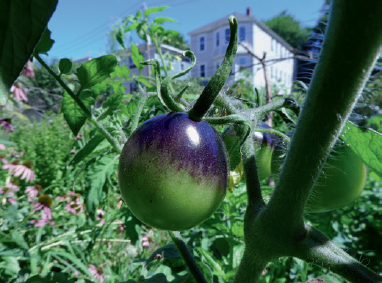
The unusually coloured Indigo Rose tomato, a blue tomato cultivar.
The tomato is arguably the most widely grown vegetable in the world, cultivated as far north as Iceland and as far south as the Falkland Islands. Tomato seedlings have even been grown in space, circling the Earth by satellite. However, the plants very ubiquity has given us both the best and worst of horticultural practice, encompassing both global big business and the noble heritage-seed saver.

